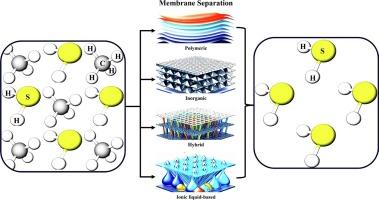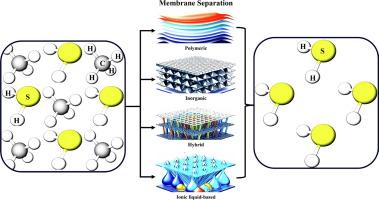Hydrogen sulfide removal from biogas: An overview of technologies emphasizing membrane separation
IF 9
1区 工程技术
Q1 ENGINEERING, CHEMICAL
引用次数: 0
Abstract
Biogas desulfurization is crucial for its efficient utilization, as the presence of hydrogen sulfide (H2S) poses significant environmental and operational challenges due to its corrosiveness and toxicity. Conventional H2S removal methods, such as absorption and adsorption, have been widely employed but suffer from high operational costs and energy-intensive processes. Membrane technology has emerged as a promising alternative due to its energy efficiency, modularity, and lower environmental impact. Although membrane-based gas separation has been extensively studied for CO2 removal, there remains a critical gap in the literature focused on H2S removal, particularly in the context of biogas purification. This review aims to address that gap by providing a focused and comparative evaluation of membrane technologies for H2S removal. A comprehensive review of H2S removal membrane technologies, such as polymeric, inorganic, mixed matrix membranes, and supported ionic liquid membranes (SILMs) is presented. The primary discussion covers materials and their performance, with the fundamental aspects related to the separation mechanism. The scalability and economic viability of membrane separation technologies are also discussed to assess their feasibility for upscale applications. The outlook and perspectives of MMMs for H2S removal are also provided. This review offers insight into the potential of various membrane technologies for H2S removal in biogas purification applications. Besides, this review also includes a discussion from the perspective of membrane materials and innovation pathways for efficient and sustainable H2S removal, supporting the broader deployment of membrane-based biogas upgrading solutions.


从沼气中去除硫化氢:强调膜分离技术的概述
由于硫化氢(H2S)的腐蚀性和毒性,其存在对环境和操作构成了重大挑战,因此沼气脱硫对其高效利用至关重要。传统的H2S去除方法,如吸附和吸附,已被广泛应用,但存在操作成本高和能耗大的问题。膜技术由于其高能效、模块化和低环境影响而成为一种很有前途的替代技术。尽管基于膜的气体分离已经被广泛地研究用于去除CO2,但在专注于H2S去除的文献中仍然存在一个关键的空白,特别是在沼气净化的背景下。这篇综述旨在通过对膜技术去除H2S的重点和比较评价来解决这一空白。综述了聚合物膜、无机膜、混合基质膜和负载离子液体膜(SILMs)等脱除H2S膜技术的研究进展。主要讨论材料及其性能,以及与分离机制有关的基本方面。讨论了膜分离技术的可扩展性和经济可行性,以评估其高档应用的可行性。展望了MMMs去除H2S的前景。本文综述了各种膜技术在沼气净化应用中去除H2S的潜力。此外,本文还从膜材料和创新途径的角度进行了讨论,以实现高效和可持续的H2S去除,为膜基沼气升级解决方案的广泛应用提供支持。
本文章由计算机程序翻译,如有差异,请以英文原文为准。
求助全文
约1分钟内获得全文
求助全文
来源期刊

Separation and Purification Technology
工程技术-工程:化工
CiteScore
14.00
自引率
12.80%
发文量
2347
审稿时长
43 days
期刊介绍:
Separation and Purification Technology is a premier journal committed to sharing innovative methods for separation and purification in chemical and environmental engineering, encompassing both homogeneous solutions and heterogeneous mixtures. Our scope includes the separation and/or purification of liquids, vapors, and gases, as well as carbon capture and separation techniques. However, it's important to note that methods solely intended for analytical purposes are not within the scope of the journal. Additionally, disciplines such as soil science, polymer science, and metallurgy fall outside the purview of Separation and Purification Technology. Join us in advancing the field of separation and purification methods for sustainable solutions in chemical and environmental engineering.
 求助内容:
求助内容: 应助结果提醒方式:
应助结果提醒方式:


